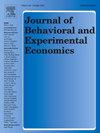“你可以辞职了!”:通过实验探索新烟盒警语的功效
IF 1.4
3区 经济学
Q2 ECONOMICS
Journal of Behavioral and Experimental Economics
Pub Date : 2025-09-29
DOI:10.1016/j.socec.2025.102452
引用次数: 0
摘要
针对吸烟对健康的影响,印有健康警告的香烟包装已被证明是有效的。然而,在帮助吸烟者戒烟和/或阻止开始吸烟方面,增强或修改是否会扩大其影响仍未确定。我们的目的是通过使用心理学和经济学文献中确定的不同动机杠杆,为这个问题提供新的证据。我们基于承诺、认知失调、授权和电子尼古丁传递系统的使用开发了新的警告。为了确定哪种类型的警告是最有效的,我们进行了一项在线实验,参与者(n = 860,包括335名吸烟者)暴露于特定类型的警告,使用传统的监管警告作为对照。传统的指标(情绪、反应、信念、感知效果和意图的测量)和创新的行为指标(激励相容的支付意愿)被用来评估警告的效果。在几乎所有相关方面,传统监管警告的表现至少与替代警告一样好。在这方面,替代警告令人失望,尽管与没有警告相比,有些警告具有积极作用,并可作为其他情况下补充或有针对性的警告或预防措施的基础。本文章由计算机程序翻译,如有差异,请以英文原文为准。
‘You can quit!’: Exploring the efficacy of new cigarette pack warnings through an experiment
In response to the health impacts of smoking, cigarette packs with health warnings have proven effective. However, it remains undetermined whether enhancements or modifications could amplify their impact, in helping smokers to quit and/or deterring initiation. We aimed at providing new evidence on this issue by using different motivational leverages identified in the psychology and economic literature. We developed new warnings based on commitment, cognitive dissonance, empowerment and Electronic Nicotine Delivery Systems use. To determine which types of warnings are the most effective, we conducted an online experiment where participants (n = 860, including 335 smokers) were exposed to a specific type of warning, using conventional regulatory warnings as a control. Traditional indicators (measures of emotions, reactions, beliefs, perceived efficacy and intentions) and an innovative behavioural indicator (incentive-compatible willingness-to-pay) were used to assess the efficacy of the warnings. The conventional regulatory warnings performed at least as well as the alternative ones in almost all the relevant dimensions. In this respect, alternative warnings are disappointing, although some have a positive effect compared to no warning and may be used as a basis for complementary or targeted warnings or prevention measures in other contexts.
求助全文
通过发布文献求助,成功后即可免费获取论文全文。
去求助
来源期刊
CiteScore
2.60
自引率
12.50%
发文量
113
审稿时长
83 days
期刊介绍:
The Journal of Behavioral and Experimental Economics (formerly the Journal of Socio-Economics) welcomes submissions that deal with various economic topics but also involve issues that are related to other social sciences, especially psychology, or use experimental methods of inquiry. Thus, contributions in behavioral economics, experimental economics, economic psychology, and judgment and decision making are especially welcome. The journal is open to different research methodologies, as long as they are relevant to the topic and employed rigorously. Possible methodologies include, for example, experiments, surveys, empirical work, theoretical models, meta-analyses, case studies, and simulation-based analyses. Literature reviews that integrate findings from many studies are also welcome, but they should synthesize the literature in a useful manner and provide substantial contribution beyond what the reader could get by simply reading the abstracts of the cited papers. In empirical work, it is important that the results are not only statistically significant but also economically significant. A high contribution-to-length ratio is expected from published articles and therefore papers should not be unnecessarily long, and short articles are welcome. Articles should be written in a manner that is intelligible to our generalist readership. Book reviews are generally solicited but occasionally unsolicited reviews will also be published. Contact the Book Review Editor for related inquiries.

 求助内容:
求助内容: 应助结果提醒方式:
应助结果提醒方式:


